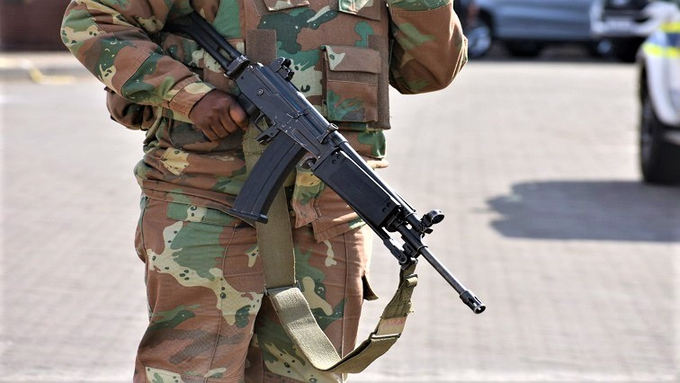Remains of 14 SA soldiers killed in DRC have arrived in Uganda! The mortal remains of the 14 South African National Defence Force (SANDF) soldiers have arrived in Entebbe, Uganda, following unexpected delays in the repatriation process. The soldiers, who were deployed as part of a multinational Southern African Development Community (SADC) peacekeeping mission, lost their lives in the eastern Democratic Republic of Congo (DRC) two weeks ago.
Their deaths serve as a stark reminder of the dangers faced by South African troops involved in international peacekeeping missions. The soldiers were part of an ongoing effort to stabilise the conflict-ridden region, which continues to be plagued by violent clashes between the DRC military and M23 rebels.
Delays in the Repatriation Process
Initially, the United Nations (UN)-led operation planned for the remains of the fallen SANDF members to arrive back home on Wednesday. However, the transfer was disrupted due to security risks and rising tensions in the DRC and neighbouring states.
What was meant to be a one-day repatriation operation turned into a three-day ordeal, as authorities navigated logistical and safety challenges in war-torn areas. The situation underscores the volatile nature of the conflict, which has intensified in recent months, leading to mass displacements and further casualties.

Official Statement from SANDF
SANDF spokesperson, Siphiwe Dlamini, confirmed the arrival of the soldiers’ remains in Uganda, stating that necessary procedures were now underway.
“The mortal remains of the South African National Defence Force (SANDF) Soldiers arrived in Entebbe, Uganda. The standard pathology procedure will proceed. It is anticipated that all necessary procedures will be completed by no later than Tuesday, 11 February 2025. Further updates will be duly communicated.”
The standard pathology procedures include identification, verification, and formal documentation before the bodies can be flown back to South Africa. The delays have undoubtedly added to the anguish of the fallen soldiers’ families, who have been awaiting their return for closure and funeral preparations.
The Role of SANDF in the DRC Conflict
South African troops have been engaged in the Democratic Republic of Congo as part of a broader SADC initiative, working alongside international forces to curb the violence between government troops and armed rebel factions.
The DRC has been embroiled in conflict for decades, with the M23 rebels being among the most prominent insurgent groups in the region. They have been fighting the Congolese government over territorial disputes, political grievances, and control over resource-rich areas.
The deployment of SANDF soldiers in the region is aimed at restoring stability and supporting diplomatic efforts to de-escalate tensions. However, the escalating violence and unpredictable security conditions pose significant risks to peacekeeping troops on the ground.
Impact on Families and the Nation
The loss of 14 soldiers is one of the biggest tragedies for the SANDF in recent years, marking a significant blow to South Africa’s peacekeeping efforts. For the families of the fallen troops, the delay in repatriation has added to their grief and distress.
Many military families make immense sacrifices, supporting their loved ones as they serve in dangerous missions far from home. The slow return process has sparked concerns about whether enough security measures were in place to protect the soldiers deployed in such a volatile environment.
President Cyril Ramaphosa and senior SANDF officials are expected to honour the fallen soldiers in an official ceremony once their remains arrive in South Africa. The national government has also expressed its condolences and support to the families affected by this tragedy.

The Broader Implications of the DRC Conflict
The death of South African troops in the DRC highlights broader concerns about the stability of the region and the long-term effectiveness of peacekeeping missions. The M23 rebellion is just one of many violent conflicts in the DRC, which has been facing internal unrest, political instability, and humanitarian crises for decades.
International bodies, including the African Union (AU) and the United Nations (UN), have urged all parties to engage in peace talks to prevent further bloodshed. However, diplomatic efforts have struggled to gain traction, as the conflict is deeply rooted in historical grievances, ethnic tensions, and competition over valuable natural resources such as gold, diamonds, and coltan.
With ongoing instability in the region, SANDF and other peacekeeping forces remain vulnerable to attacks, raising questions about South Africa’s continued military involvement in the DRC.

Conclusion: A Nation in Mourning
As the mortal remains of the 14 SANDF soldiers undergo final procedures in Uganda, South Africa awaits their return with heavy hearts. Their bravery and sacrifice in the pursuit of peace will be remembered and honoured.
The tragedy serves as a harsh reminder of the risks faced by peacekeeping troops, as well as the need for stronger conflict resolution mechanisms to bring lasting peace to the Democratic Republic of Congo.
The coming days will be marked by grief, reflection, and national mourning, as families and fellow soldiers prepare to lay their loved ones to rest.





















